Real-World Evidence: From Volume to Value
Pharm Exec convenes an expert Roundtable to discuss one of the hottest topics in big data today-how to make that data relevant to payers, regulators and the patient through reliance on real-world evidence in driving better health outcomes.
Real-world evidence (RWE) is the intersection between the structured rigor of the randomized clinical trial (RCT), and the clinical exposure a treatment receives once it enters medical practice. As explored in the following Roundtable discussion, drug manufacturers, payers, regulators and patients are grappling with the practical application of this tool as the US health system moves toward a new payment model focused on value rather than volume. The challenge is that current standards for incorporation of RWE in decisions on market access lag well behind the desire to do so. Work in this area is often seen as variable, incomplete and unreliable compared to the “gold standard” of the RCT.
Photo: John Halpern
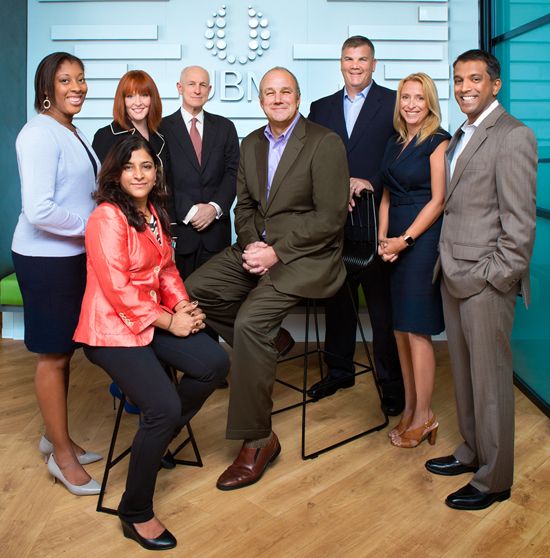
William Looney, Pharm Exec: The purpose of our discussion today is to add some clarity to the RWE discussion, in three areas.
The first is Definition - can we build some granularity into the concept of RWE? What’s meaningful and usable beyond the clinical trial itself? How do we address the larger question of interpreting what “value” is in medicine, particularly as stakeholders view the concept from many different perspectives?
The second is Use - what are the barriers to actually applying RWE as an evidentiary tool in key decisions that drive the drugs business, such as indication, labeling, access and reimbursement?
The third is Result - how do we build toward the dissemination and acceptance of RWE data that can document improved health outcomes, particularly those that matter to patients. Are payers and regulators prepared to implement these findings, consistently, to make our system more patient centric, realize the promise of personalized medicine and improve the risk-reward environment for innovators?
Beyond these three points, what mission critical issue do you believe will help foster a decision-making infrastructure shaped by RWE?
Kai Carter, HeartFlow Inc.: My company is working on an evidence-based value rationale for our key product, a novel, non-invasive diagnostic for coronary artery disease. Our goal is to join with other stakeholders around a consensus on standards for use of RWE, particularly focusing on the early adopters of RWE who can benefit by having their voices elevated in the debate.
Tom Langan, Practice Fusion: I am CEO of an enterprise whose lead product is a cloud-based ambulatory electronic health record (EHR) designed to help providers manage the transition to value-based reimbursement. Incorporating RWE seamlessly into the practice is one of our key objectives. To do that, we have to identify and solve for the data gaps that confront the provider.
Bimal Shah, Premier Research Services, Premier Inc.: I have been working with outcomes data and RWE for close to 20 years. What interests me is addressing the hype around RWE. While RWE provides enormous opportunity, it needs to be better grounded in reality that accounts for the scope and boundaries of what it can and can’t do? And what does the future of RWE look like? We know that the silos of information in
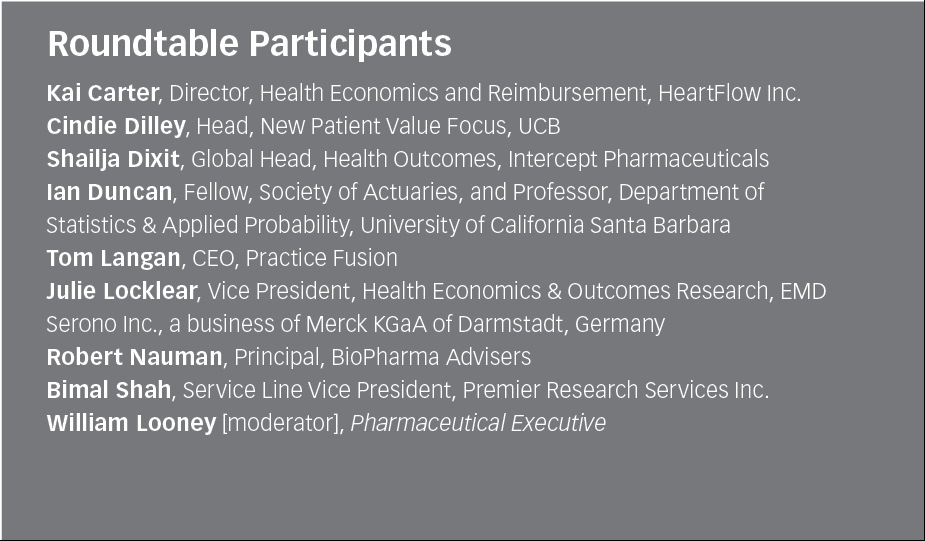
healthcare are being digitized, but the real question is when will they be linked?
Ian Duncan, Society of Actuaries: My career has centered on starting and managing companies that specialize in data analytics. I have mainly worked on the payer side, including a stint as head of clinical research for the Walgreens pharmacy chain. RWE is viewed as something distinctive and new in the pharma space, but as a payer I can say it represents the essence of what we have been doing for decades, which is to concentrate our efforts on outcomes driven by the day-to-day clinical experiences of providers and their patients. What attracts my attention here is how pharmaceutical companies are putting forward a value proposition to help them survive in a world where medicines will thrive only if they can show that prescribing will lead to a better outcome for the patient.
Cindie Dilley, UCB: I am an economist and represent a team within UCB that focuses on new product innovation through the intersection of medicine, technology, and data analytics, coupled with a deep understanding of patients. Our belief is that a business model centered on providing the medicine alone is less sustainable for the future. What drives me is finding insights to connect streams of data and make it more viable for the entire development chain, from discovery to commercialization. We will not make the transition to personalized medicine until we make this connection. Personalized medicine is more than choosing the right drug for the right patient. It’s also about targeting the right combination therapy, selecting the best companion diagnostic, or tapping into an artificial intelligence algorithm that will secure an entire treatment pathway fixed on the patient’s unique clinical profile.
The point is more sophisticated patient stratification is necessary at every point in the development process, through things like genetic markers in oncology or artificial intelligence in epilepsy. A clinical trial drawn from a set of hypotheticals on the ideal patient will not substitute for leveraging RWE to inform us about the actual patient.
Julie Locklear, EMD Serono, a business of Merck KGaA: I lead our US Health Economics and Outcomes Research group, which is part of Medical Affairs. Challenges include establishing an internal organizational consensus on RWE as a business practice, of end-to-end evidence generation in support of clinical development, pre-launch and launch optimization. We support patients with difficult-to-treat diseases. This fundamental shift in the way we develop medicines often necessitates significant changes to internal structures and processes. Setting up the RWE function and selling it internally is critical to success. Do we have an inventory of best practices? What are the lessons learned?
Shailja Dixit, Intercept Pharmaceuticals: My concern is RWE has failed to establish enough traction to overcome skeptics who doubt its clarity and robustness. This view has an adverse impact on using RWE in decision-making on access. RWE remains a gray area in the clinical judgment armamentarium of payers and providers, so that means you cannot make this information accessible in a way that benefits patients. Few will be inclined to make big investments in RWE until this changes.
Robert Nauman, BioPharma Advisors: These are all excellent examples of what is “state of the art” for RWE. We agree on the necessity to improve on those three elements of RWE -Definition, Use, and Results-outlined by our moderator today. It’s true that much of what RWE represents is still potential, not established practice. The road has been surveyed, but it needs now to be paved.
We also have to look at RWE in the context of larger forces affecting the US health system. In just a few decades, we have moved from a situation where the incentive was to consume services without any reliance on information to today’s emphasis on managing health resources by leveraging an abundance of information. Despite this, the cost of healthcare per capita is continuing to grow at an exponential rate. The question, therefore, becomes: are we using this information correctly, for the overall purpose of aiding the desired shift from volume to value?
Of course, definitions do count but it is not just RWE that lacks an agreed nomenclature. Almost every health practice confronts the same problem. Population health is wide open to interpretation, but vast swaths of the health system now claim it
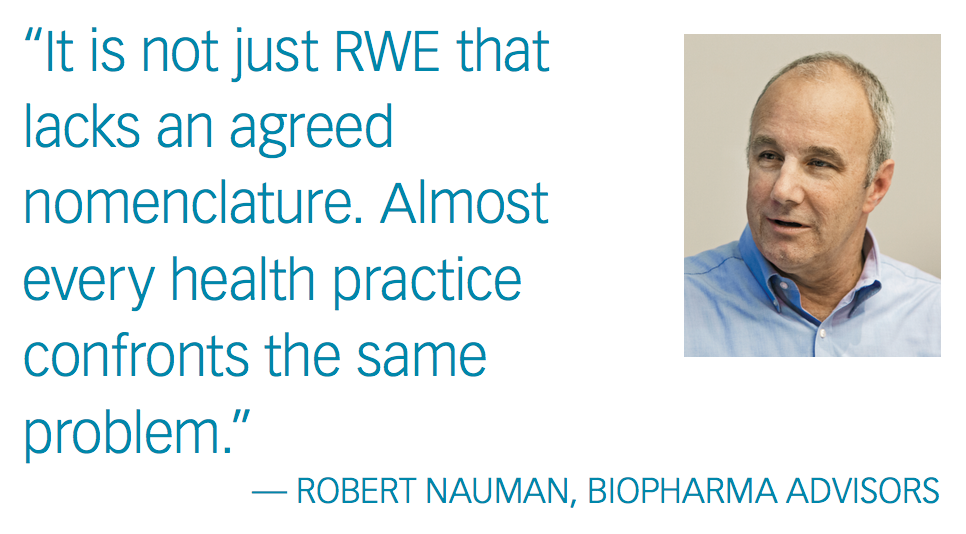
as a governing principle. The same is true about precision medicine; it’s still seen as an aspirational concept among patients and providers. And translational medicine requires its own translation, with the lingua franca dependent on the eyes of the beholder.
It’s equally important to factor in ongoing issues like the capacity to predict treatment responses in individual patients. Will technology rise to the occasion and improve on tools like predictive analytics to better account for treatment effects, especially in high-risk patients? We also have to cite regulatory issues, such as patient privacy protections, which often have unanticipated consequences as a barrier to progress in care delivery.
Looney: Perhaps the common denominator here is the patient and the outcome from the treatment he or she receives. Isn’t this where we should focus our efforts to define each practice?
Shah: There is nothing wrong with the fact that we struggle with placing things like RWE into neat categories. Health itself is not easy to define, and any patient outcome is going to be evaluated through the lens of where you sit in the system. A clinician may look at a treatment outcome differently than a technology provider, a drug or device manufacturer, a payer-or the patient.
What’s universal is the scope and quality of the data that feeds into the institutional decision-making chain. The data is where it all starts. Finding data sources relevant to solving a clinical problem is the hard part, so labeling those sources correctly is the holy
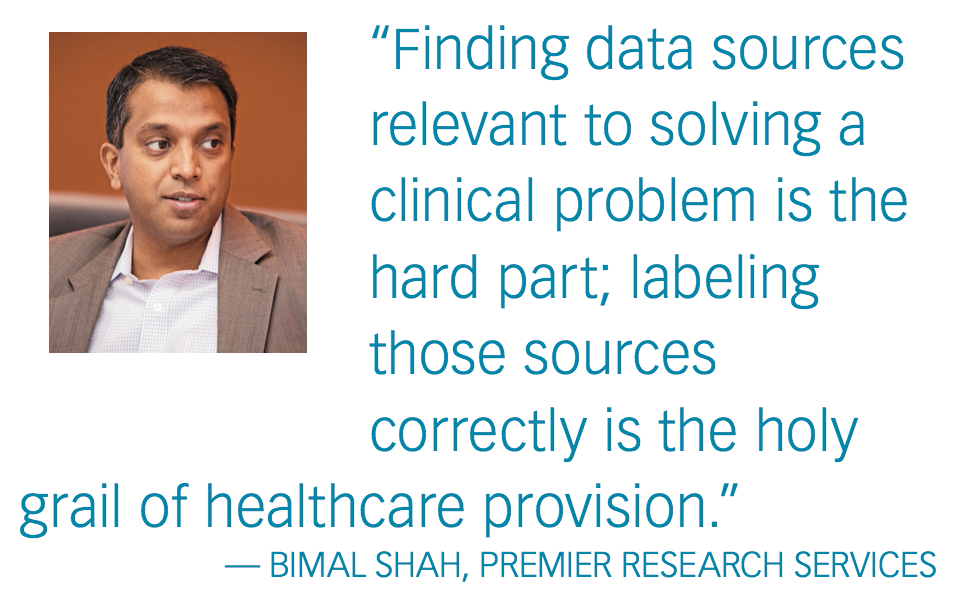
grail of healthcare provision.
Langan: The source point is the challenge. Most EHR data is collected on the premises of a practice, so there is no incentive to standardize. Whether it’s an in-patient or ambulatory service, what you have are inconsistencies across the industry. If we don’t fix it, it will be that much harder to produce effective outcomes and studies.
Nauman: What every player in healthcare wants is to be able to track that “patient journey” through the treatment cycle. The desire is to measure something, but then we find the ability to consolidate the data might not exist. What encourages me is the drug industry is being motivated to work with providers on new approaches to collect and interpret data. There is common ground that this process can improve health outcomes.
Another challenge is the inefficient scale. Under the Affordable Care Act, the US has an abundance of pilot schemes underway to help grow RWE but, as the saying goes, small samples are always inconclusive. That’s why you don’t see much progress in inserting RWE into key chronic disease areas like diabetes and heart disease.
Dilley: And the data is so unstructured, it is irrelevant to tracking outcomes involving such truly big patient populations, as there is no single approach to mining the data.
Langan: Providers know the world they work in is changing, and that one of the most disruptive aspects is all the new technology they now must use to meet their practice’s obligations to payers and regulators. It’s far from clear that providers really know how to
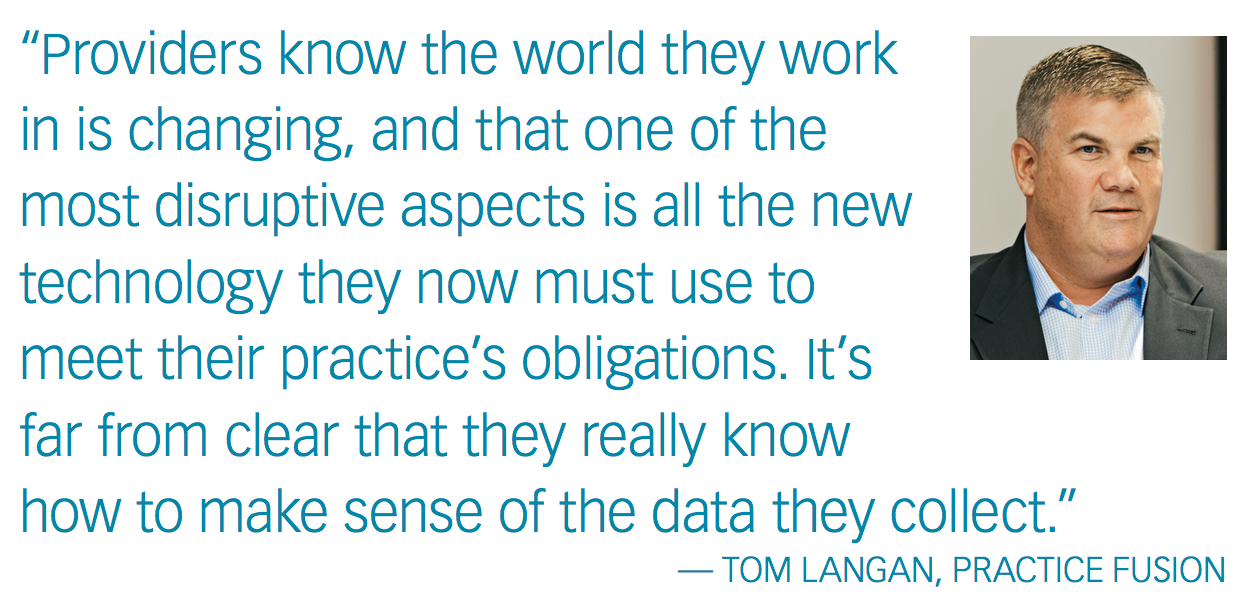
make sense of the data they collect.
Dixit: The pace of technological change and the pace of change in data governance arrangements are not moving in tandem with RWE needs. The delay causes significant frustration for stakeholders. To make RWE an integral part of drug development and launch, data needs to be processed, analyzed, and presented in a coherent format acceptable to the broad range of interests involved.
Shah: Unstructured data is dirty data-both in and out. I think the current work flows mandated by technology are seen by many providers as intrusive and inhibiting. There are a lot of work-arounds at the back end of the practice to help them get through the day. As long as data is unstructured, it will be hard to conclude it is representative of what is really going on in the practice in terms of the actual patient experience.
Looney: I’d like to pose a question to Ian Duncan. You said earlier that, as a payer representative, there was little angst about applying RWE to decisions on which treatment option produced a better outcome. What’s your reaction to what you’ve heard from the group so far?
Duncan: Payers benefit from a singular perspective-it’s all about economics. We also have large and very credible data sets. The methodologies for determining effects from the data are not perfect but it’s reasonably good and getting better. In addition, payers don’t have to conduct clinical trials. Our focus is entirely on the real world of patients. Twenty years ago, when I started in the business, it was possible for pharmaceutical companies to pay health plans to do these evaluations from the data. There was an interest in partnering to track what was going on and craft solutions. Today, it is much more difficult to carve out that common ground. And there are now so many more drugs and devices it’s hard to tease out the various effects.
Locklear: There is a conundrum between innovative medicines that provide valuable treatment, often over the long-term, and traditional healthcare plans that are measured upon annualized economic costs.
There is growing interest in collaborations from many research, academic groups, and US health plan organizations to work together with drug manufacturers to provide access to innovations while managing the costs associated with specialty medications. These collaborations can provide valuable information, which can be shared as best practices. However, we see some hesitation from plan organizations to release such information, even when de-identified.
Carter: Payers are interested in arrangements that allow for replication of the results of a drug company’s clinical trials while being able to access real-world data and experience as well. This can be helpful and frustrating at the same time. The obvious problem is jeopardizing use of evidence that could be applied to approvals of additional indications.
Dilley: We had discussions with a closed system payer on joint field work and clinical testing, which we could sponsor on the condition that we rely on data drawn from its own EMR system. We must pay for any coding and application development required to extract data from that system. If we want to use that data for a project with another payer, there are additional fees, as they would want us to set up something similar with their own data and thus we would need to recode everything again to deal with their own systems procedures. Hence, there is an interoperability issue with EMR systems that complicates trying to do anything at scale.
New regulations designed to encourage interoperability of data are gradually coming into force over the next few years. The changes will remove some of the barriers to scaling up projects by allowing greater participation. This, in turn, could make RWE projects more viable financially.
Nauman: Payers should be most interested in RWE studies that compare the leading treatments in a defined disease area, with the evidence establishing one of the studied therapies as the winner and setting the base for category reimbursement. Is it possible to engage a biopharma company to participate in this kind of exercise?
Locklear: This is possible. At EMD Serono, we are interested in collaborating with health plans to better understand how effective our medicines are in the real world, in patients with co-morbid conditions and concomitant medications-often with different patient characteristics than those included in pivotal clinical trials utilized for regulatory registration.
The RWE studies we design are rigorous and provide insight into the effectiveness of products as the market becomes crowded with multiple medications treating similar diseases. Multiple organizations in the US assess or provide the tools to assess medications, including ASCO’s value framework, Memorial Sloan Kettering’s Drug Abacus, and the Institute for Clinical and Economic Review (ICER). It is important that the dialogue among organizations that conduct such reviews, as well as manufacturers and patient advocates, stays active.
Duncan: The closest you get to this concept is the UK National Institute for Health and Care Excellence (NICE). NICE and the government get to determine which products are the winners.
Dilley: The UK and European approach inspires you to look at patient outcomes and clinical trials in a different way. By forcing companies to conduct head-to-head trials, sponsors and participants will pay closer attention to where the advantage point is in each market and how to structure endpoints to incorporate different subpopulations that might not currently be served by a particular medicine. There is less pressure to produce this kind of evidence in the US, which means resources can be used less efficiently as “me-too” drugs still find a niche.
Looney: Is the patient experience accommodated in the current approach to evidence generation? It would seem that RWE is superbly positioned to add this experience to the decision set on access and reimbursement.
Shah: It varies by therapy area. Patient-reported outcomes (PRO) is a validated tool incorporated in clinical trial studies to secure a label that widens the potential patient population. The problem is that PRO is not consistently applied and payers, in particular,

are skeptical about its applicability against the gold standard of the clinical trial.
Dilley: Validation is at the heart of the debate on making evidence work for the patient. PRO and other validation models (wearables, for example) must confront the gold standard of the clinical trial. By that measure, each of these anecdotal, experience-driven tools-like the daily patient journal for cancer patients-are likely to fall short. We have had 50 years of process by which we define an outcome usually as an objective measure. You have to consider everything else against that underlying reality. How do we find a way to include PROs without 50 years of re-validation across disease categories?
Looney: Is the regulatory and reimbursement environment fit for purpose in addressing these problems and paving the way for acceptance of RWE?
Locklear: The situation could be improved. FDA has expressed interest in RWE data, as such data has been utilized for decades to obtain evidence of the safety of FDA-approved medicines. The effectiveness of such medicines, as realized by RWE, is what still requires hard work and perseverance. The reimbursement environment in the US is fragmented, with healthcare organizations conducting independent reviews and third-party organizations such as ICER generating class reviews on its own, where open communications and collaborations could benefit.
Langan: The FDA is more open today in working with biopharma companies-and the partners these companies work with-in understanding and applying new technologies to improve safety, the quality of evidence, and to foster two-way communication.
Carter: I still see a disconnect between what the FDA does and the positioning of the Center for Medicare and Medicaid Services (CMS) in respect to access and reimbursement. The disconnect expresses itself on the evidence front, where we rarely
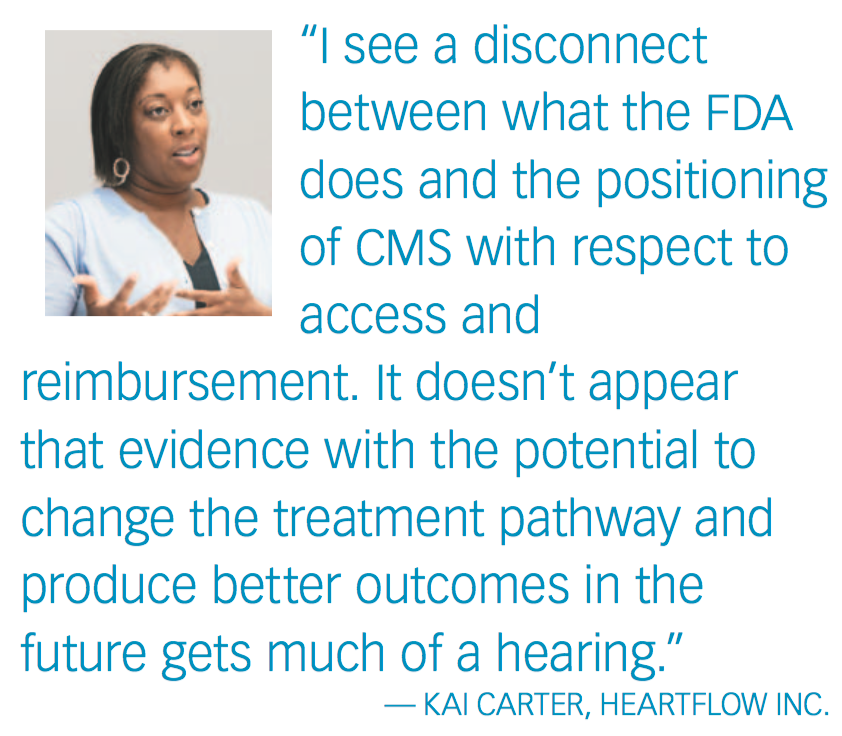
know how much value the FDA attaches to certain data as well as the reflexive reaction to submissions-asking for still more data. It doesn’t appear that the kind of evidence with the potential to change the treatment pathway and produce better outcomes in the future gets much of hearing.
Looney: What about the provider side? How are they accommodating to pressure to demonstrate value with evidence?
Shah: Providers are undergoing a major business model transition that will impact expectations about all forms of evidence and how it is used. The key trend is that providers are having to take on more risk, because they are establishing their own health plans to fuel the activities of much larger group practices. In the future, this means potentially thousands of new payers will be entering the market. Their standard of evidence is going to be different than that of the larger commercial payers, the FDA and CMS. They are also going to generate more data internally and will want to leverage that toward proving outcomes as well. Smaller plan operations-those ranging from about 100,000 covered patients to a million-are also more integrated, so they are likely to take greater interest in incorporating the patient experience when deciding to pay for expensive medicines. I predict they will use comparators and formulary decisions to accumulate RWE at a faster pace than the biggest players.
Carter: Another characteristic of provider consolidation is a greater willingness to pool their data with other sources in pursuit of decisions on value. These organizations realize the need to aggregate. A good example of an “early adopter” in this space is work my company is doing with Highmark and the Allegheny Health Network. The two have created the VITAL Program, which seeks to partner with cutting-edge tech companies to develop a RWE process that leads directly to a reimbursement decision. That’s the agreed endpoint; there is no other competing or extraneous objective to confuse things. It’s a nice slant on what you normally see from the evidence side.
Looney: Is the cascade of industry interest in being “patient centric” leading to positive change in the level of acceptance of RWE? It’s a contradiction to embrace the patient while downplaying the utility and relevance of evidence drawn from the clinical setting.
Locklear: Patients are at the center of what we do every day. The patient voice is now accentuated and more accessible through the expansion of social media. Payers must regard the patient as a customer, with high deductibles and co-pays impacting the decisions patients and care-givers take on their health. How to integrate the patient voice without adding too much subjectivity to the evidentiary process is a challenge.
Dilley: The patient perspective is going to matter much more-because patients are learning all about technology. And technology is an empowering force. The concept of the patient portal, as it evolves, will put the patient in a position to decide how to access and distribute information on his health status and condition, all with a simple “hit send” on the email. Apple’s health kit has the functionality to aggregate all this into large data sets, which, in turn, will give patient advocates the power to not only demand and design a topical study, but even serve up the data from its own patients’ records.
What is most exciting to me about this is the potential in connecting data to create insights we don’t have today. I focus on predictive analytics The biggest flaw in this instrument to date is that data silos mean our models do not have enough data-and that makes the difference between a tentative and a definitive outcome.
Shah: Even good data runs up against patient heterogeneity, a defining characteristic of the CVD area I practice in. The consultation notes I prepare after a visit for three individual heart failure patients or three individual atrial fibrillation patients are invariably very different. The ability to compile data even within this fairly defined cohort, in a manner where meaningful inferences can be identified, is limited.
Dilley: I’d point out that big data was originally intended to serve as a screen against the extraneous “noise” factor. Machine learning and artificial intelligence (AI) are designed to uncover patterns and relationships that the data fails to reveal on its own in smaller numbers. Each of these tools is being applied extensively in every other sector-except healthcare. Instead, we are forced to make hypotheses based on hunches that rely on random, individual human expertise.
It’s always challenging to persuade clinicians to go beyond that and embrace these autonomous, new technology models structured to uncover all those underlying relationships and pinpoint the common ground. If you cannot explain this process to clinicians in a way that confirms its accuracy, and avoids the “black box” connotation of AI, you will find that, to them, such data has no value. Their response is akin to throwing the baby out with the bath water. This continues to be the major barrier in applying RWE and big data to solve problems in healthcare.
Looney: If the transition to these new tools is well underway in other sectors like consumer goods and financial services, why can’t the same evolution occur in healthcare? Is it the different risk profiles? Ingrained practice patterns? The conservatism of professional guilds?
Shah: Professional practice in healthcare has yet to catch up with the technology. Disease standards are complex. As a cardiologist, I am aware of at least eight different definitions of a male or female having a heart attack. So how do you form a consensus on what is a heart attack, how are you going to define who is having one, and how are you going to report it?
Much of the problem reverts to the stage this industry is at relative to other sectors. We did not have access to big data in healthcare until a little less than 10 years ago. In finance, the transition goes back to the 1980s and in consumer, the mid-1990s. I see a lot of this as a timing issue. People have to understand and adapt.
Langan: We have already mentioned privacy issues and other elements of regulation that are largely unique to this industry. Each institutional platform in healthcare is different and their capacity to employ data technology will vary, though the trend now is that everyone is moving from an on premise server-based system to cloud-based technologies. There is convergence, but the industry still has work to do.
Shah: Many businesses in healthcare operate on razor-sharp margins. Investments in data are expensive and time consuming. We see a trend that boards of directors are asking management tough questions about the ROI on this spending; many CIOs are struggling to quantify it. If you have just spent half-a-billion dollars on these systems, that’s a tough position to be in. It’s no surprise that a sense of deceleration has taken root.
Dilley: Don’t forget the “adoption curve.” Technology is asking the physician to change; to behave and do their work differently, less on being the sole decision-maker on therapeutic options for the patient and more focus on their bedside manner. Many physicians entered the profession because of the decision-making autonomy it provided, so sharing this role with non-human decision tools requires an adjustment.
Looney: Overall, should we be optimistic that such barriers will be overcome to realize the promise of RWE?
Shah: We can be optimistic that systems interoperability will progress, if only due to pressures from the regulatory side. There are still some issues affecting RWE on reconciling differences from one platform to another. Specifically, we need common data models and definitions around the type of information these models collect.
Nauman: I’d like to ask Ian Duncan if he has any reaction to this discussion among our industry colleagues about missing instruments and data gaps, given his earlier comment that payers have all the information they need to make informed choices about value.
Duncan: My point is that through my experience at Walgreens and a number of accountable care organizations, I can attest to our capacity to track what’s going on in regard to terms of service, claims and payment. Of course we lacked the insights from original sources like PRO, which is still on the frontier for payers.
The bottom line is value. Value-based purchasing as touted by CMS and others sounds good in theory, but. practically. what is going on here is allowing a third party like CMS to decide what value is for everyone else. PRO represents an alternative voice that potentially widens the circle of influence in making value judgments. But it’s a fairly
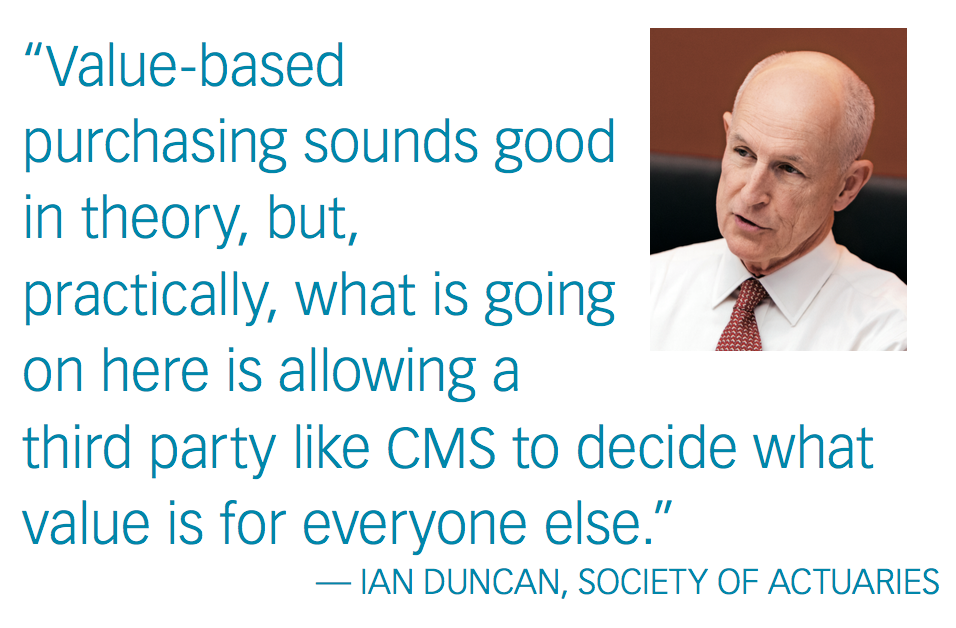
crude tool. And we continue to pay for products that many stakeholders will value not as something first and foremost but as something third hand. What the payer wants is data that determines whether drug A versus drug B will yield a better outcome in specific areas and is thus worth being reimbursed.
What payers worry about most today is obtaining the integrated sets of data capable of delivering that kind of result from research. Complete data from providers and industry clients is not only harder to obtain but is filled with gaps and discrepancies. HIPAA requirements remain a sore point and impediment to the private sector in disclosing their data to us.
Langan: Everyone-not just payers-wants access to integrated data. The gaps in data remain daunting. It involves density or longitudinal issues; the reason for some data being inputted is not always clear on its face, and it’s often completely unstructured. Our clients are looking across multiple providers to help them integrate it. Another objective is finding vendors with the kind of data that can help engage the patient.
Looney: I’d like to ask those of you from big Pharma how you address internal issues within the organization relating to the application of RWE through the development, commercialization and post-marketing stages. How hard is it to do all the tasks that relate to achieving market access for your company’s medicines?
Locklear: RWE is a topic that readily engages everyone in our industry. There is very strong support for the concept in that it ties us to interests of the patient in an actual clinical setting. In fact, it is a contradiction to support the importance of good outcomes for patients while eschewing use of RWE, observational studies and other evidence
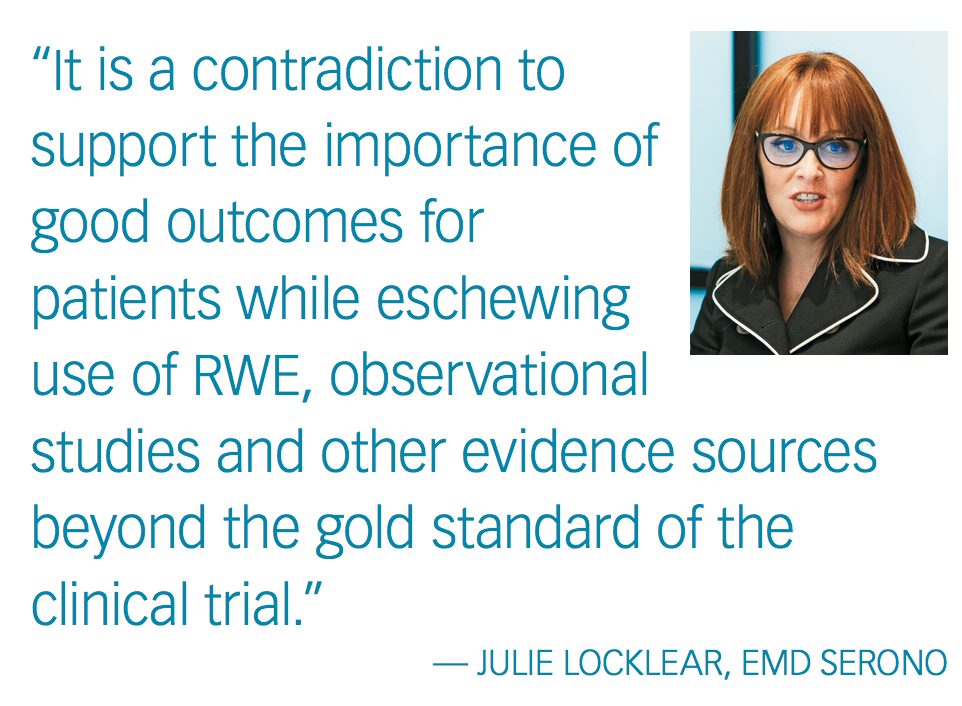
sources beyond the gold standard of the clinical trial.
The challenge is, again, a matter of definitions. Our function is usually classified as health economics and outcomes research (HEOR). Its sounds very academic. We are deeply engaged in areas ranging from early-stage development to medical affairs and reimbursement.
Most of us working in this area see ourselves as innovators, even disruptors. As a “center of excellence,” we persuade colleagues to leave their comfort zones and recognize that patients, providers, payers, and other key stakeholders may choose to look at our products from a different lens. I am certain most of us in this work are inclined to support RWE earlier in the development stage, to actually identify those patient sub-populations best positioned to benefit from our therapies.
Langan: Another positive is the awareness of more biopharma CEOs that the value through evidence issue is strategically important and requires their direct support. CEOs are often the ones behind decisions by big Pharma to create innovation incubators or a digital health task force. I am based in Silicon Valley. I am seeing more requests from these CEOs to come see us because of their concern about being victims of data-led disruption of the biopharma business model.
Dixit: One of the actions we should take is to separate out the traditional HEOR function from the generation of RWE. The reason is that HEOR tends to narrow the scope of inquiry. By default, it forces you down a path in which there are two models that are so carefully framed that truly meaningful or unexpected insights are harder to obtain. RWE opens up the model and allows researchers to engage multiple stakeholders, which also has a beneficial impact on market access. Strong data on an HEOR study is good, but outcomes evidence alone is often not sufficient to ensure market access for the product.
Shah: Defining the protocol is the essential starting point for any form of evidence-based research. Doing it well requires educating people in their vernacular so that they understand what problem you are solving for and how the data will help to accomplish that.
Locklear: It’s also true that HEOR as a function tends to stick in people’s minds-internally, there is a presumed notion of what HEOR is supposed to do. Regardless of where it sits, there is value in distinguishing between RWE and the conventional pathways of HEOR research. There are interrelationships between the two, but also key differences, and its worthwhile to articulate these distinguishing characteristics with colleagues inside the organization.
Dixit: It’s drilled in peoples’ minds that HEOR always comes after FDA approval. That means it is a challenge to get development teams to accept input from HEOR input at the critical phase III stage toward registration.
Looney: As part of an action reform agenda, what would you recommend as the one internal priority or change that would enhance prospects for the take-up of RWE? Alternatively, what would you suggest as a key priority change on the policy or regulatory front to obtain the same objective?
Locklear: On the policy front, the industry has a number of groups-PhRMA, BIO and NEHI come to mind-providing recommendations to the FDA on expanding the range of evidence to inform the registration and post-approval process on drugs and devices. There are some common themes, but also differences.
On internal process, I would advocate the crucial connection that the CEO must make in raising the profile of RWE. We need ultimate buy-in from the very top of the organization, including recognition that HEOR and RWE are mission-critical functions.
Dixit: I point to three inter-related steps that would make our compliance with policy and regulation easier. The first is greater acceptance by the FDA and payers on pragmatic approaches to evidence, including acceptance of observational data and patient-reported outcomes in clinical trials. Companies should be encouraged to submit such evidence, not just tolerate it. This will ensure the RWE perspective is considered during the drug approval process.
The second is a stronger tie-in between regulation and its end-purpose. Creating a structure that would show what regulators and payers actually do with RWE is an example.
The third is an extension of my second priority, but focused on creating a defined framework for PRO evidence. For example, there is very little clarity about how to insert the “patient voice” into the FDA decision on a new product label. We need more granularity on this if the healthcare system is to achieve the goal of being patient centric. Right now, there is little incentive for a biopharma company to invest in PRO because the FDA guidance is so opaque.
Carter: We need a stronger consensus on defining value in the healthcare system. How is the data we generate used to shape decisions across a very diverse payer and reimbursement landscape? No answer has yet emerged on that. A first step in that direction depends on us working with other stakeholders in a systematic way, all along the full product life cycle. Consultation with stakeholders should not start and end at any one particular point, as tends to be the case today.
Langan: Regulatory policies that unleash the potential of that big data in realizing the promise of personalized medicine should be a priority, because this is where the future of medicine lies – in integrated data sets.
Looney: How do your venture capital colleagues in Silicon Valley see the trends-where is the VC community staking its claim?
Langan: The Valley is heavily focused on the measurement of value and outcomes. CEOs and executive sponsors of the events I attend are asking questions about how ready the P&R world is for RWE and the shift to value-and is your company gearing up for it too? How can you apply technology to improve the relevance and accuracy of data and use it to sow disruption in the biopharma business model? That’s another pregnant question. RWE is a sub-text in this conversation. Instead, the interest is in finding companies that have the mettle to be disruptive in a healthcare system that has to change.
Duncan: Silicon Valley is interested in anyone who can speak and interpret the language of the payer. This community knows that if you can’t convince the payer to get on board, you don’t have a business.
Dilley: UCB has a different internal perspective on big data. We start by treating all the information we generate as an enterprise asset. We have prioritized big data as a key component of our 10-year strategic plan. This means our focus is not referencing data as a functional tool designed solely to convince payers that our drug is valuable. Instead, we look at data as a strategic driver of the customer relationship, helping us to define our patients and explain how they actually respond to our drugs. Little is known about that patient response; if our data can tell us something about that, it gives us a competitive edge. We see data as an aid to patient stratification, from clinical trials all the way through to post-marketing surveillance.
The point is we don’t place our emphasis on using information just to get to reimbursement. We think if we provide value for patients, through sophisticated patient stratification informing everything we do, then reimbursement should follow. We’d like to see other companies adopt this same approach. And we have been proactive about data transparency.
On the policy front, I would like to see an industry-wide stance on data sharing. I am a big believer in the merits of data aggregation in solving the information problem in healthcare. To do that, we have to come forward as a group and declare to data providers that unless they provide us access to data that allows us to integrate it with other data, relevant to our need to produce outcomes, we will not purchase any data from them. Some companies have taken a partial step in this direction. The rest of the industry has to move on this as well, because if we can’t obtain data that responds to payer expectations of our products, or the evidence of value, how else do we make the case for access?
Looney: Looking ahead to 2020, will we still be talking about the same themes we have been raising today?
Shah: I am cautiously confident we will be having a different conversation. It won’t focus on data integration, or data strength, or data silos. Instead, we will be examining the merits of the next stage, such as how better to collect the data we need for insights. Is it structured around a common agreed format? How can we exploit advances in technology that give us better analytics and deeper insights on what the numbers are telling us? The technology is ready. The question is whether the human aspects of organization and deployment will be up to the task.
William Looney is Pharm Exec’s Editor-in-Chief. He can be reached at william.looney@ubm.com
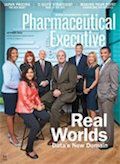
Addressing Disparities in Psoriasis Trials: Takeda's Strategies for Inclusivity in Clinical Research
April 14th 2025LaShell Robinson, Head of Global Feasibility and Trial Equity at Takeda, speaks about the company's strategies to engage patients in underrepresented populations in its phase III psoriasis trials.
Key Findings of the NIAGARA and HIMALAYA Trials
November 8th 2024In this episode of the Pharmaceutical Executive podcast, Shubh Goel, head of immuno-oncology, gastrointestinal tumors, US oncology business unit, AstraZeneca, discusses the findings of the NIAGARA trial in bladder cancer and the significance of the five-year overall survival data from the HIMALAYA trial, particularly the long-term efficacy of the STRIDE regimen for unresectable liver cancer.
Expanding Immune Response Testing to Support Vaccine Development
April 22nd 2025Nigel McCracken, chief operating officer, Virax Biolabs, discusses the expansion of its ViraxImmune platform into areas such as transplant monitoring, vaccine efficacy, latent virus reactivation, and CAR T cell therapy.